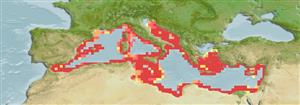Common names from other countries
Environment: milieu / climate zone / depth range / distribution range
экология
; пределы глубины 26 - 498 m (Ref. 1695). Subtropical; 46°N - 30°N, 6°W - 37°E (Ref. 1695)
Mediterranean Sea.
Length at first maturity / Size / Вес / Возраст
Maturity: Lm ? range ? - ? cm Max length : 2.5 cm ML самец/пол неопределен; (Ref. 1695); 2.8 cm ML (female)
Found along the outer shelf between 26 and 498 m depth. Mating takes place when the male grasps the female's 'neck' region, and spermatophores are placed in the female's bursa copulatrix. Males have been observed to guard females during courtship. Contributes (although in low numbers) to the local trawl fishery as one of the most frequently captured Mediterranean species of this genus (Ref. 1695).
Life cycle and mating behavior
половая зрелость | размножение | нерест | икра | Fecundity | личинки
Members of the class Cephalopoda are gonochoric. Male and female adults usually die shortly after spawning and brooding, respectively. Mating behavior: Males perform various displays to attract potential females for copulation. During copulation, male grasp the female and inserts the hectocotylus into the female's mantle cavity where fertilization usually occurs. Life cycle: Embryos hatch into planktonic stage and live for some time before they grow larger and take up a benthic existence as adults.
Основная ссылка
ссылки | координатор | соавторы
Jereb, P. and C.F.E. Roper (eds.). 2005. (Ref. 1695)
Статус Красного Списка МСОП (Ref. 130435)
Статус СИТЕС (Ref. 108899)
Not Evaluated
Not Evaluated
Использование человеком
| FishSource |
инструменты
дополнительная информация
Возраст/РазмерыростЗависимость между длиной и массой телаЗависимость между длинамиморфологияличинкичисленность
ресурсы в Интернет
Estimates based on models
Preferred temperature
(Ref.
115969): 13.2 - 16.1, mean 14.8 (based on 124 cells).
Уязвимость
Low vulnerability (10 of 100).
Категория цены
Unknown.
